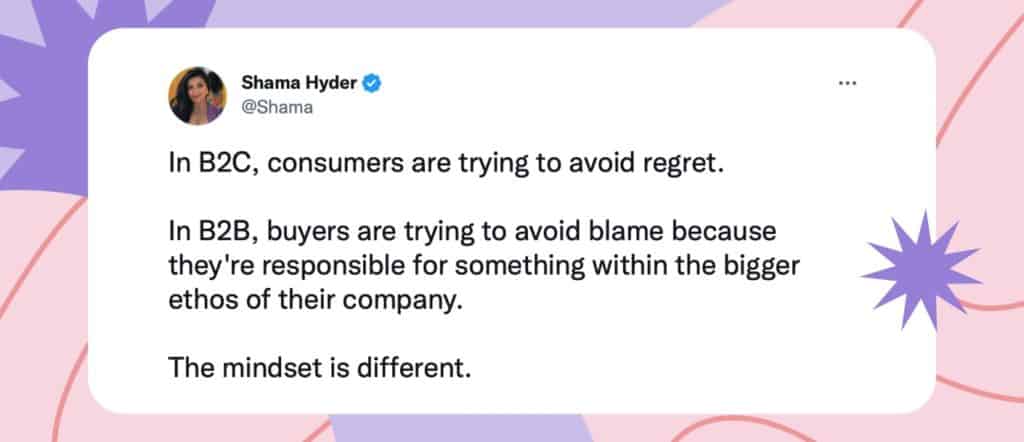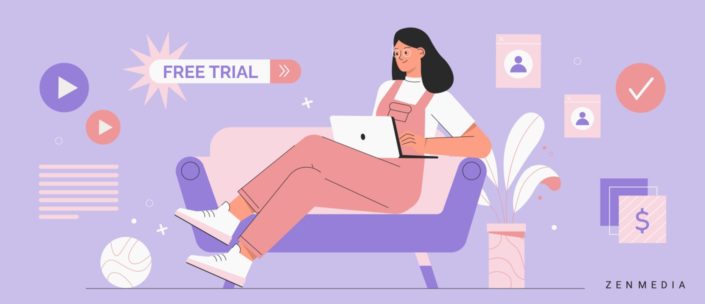Imagine booking a long flight and opting for business class over first class to save spending money. When you arrive at your gate to board, you find out you’ve been unexpectedly upgraded to first class! Now, instead, imagine booking a first-class flight initially. You arrive to board and are told that first class was overbooked for this flight, and you will either need to be demoted to business class or wait for the next flight. Psychology tells us that most people in this situation will be twice as upset over losing something they thought they had versus the feelings of happiness when they gain the same thing.
This concept is called loss aversion, and it can help strengthen your B2B marketing strategy.
What is loss aversion?
Loss aversion is the idea that people are twice as likely to be upset over losing something they already “own” than the pleasure they gain from getting something new. To put it in B2B terms, by the end of a trial period of a product, consumers have become accustomed to the solution and have integrated it into their routines. Rather than lose that option, they will be more willing to pay to prevent the loss when their free trial runs out.
Buyers also want to avoid losing money, so it is up to brands to eliminate that barrier—usually, through free trials. Humans make millions of tiny decisions daily—many we don’t even cognitively think about because our brains have developed to help us reach decisions faster in order to cope with the overwhelming amount of choices. Loss aversion kicks in when we feel we’re going to miss out on something or lose something we already have.
Everyone reading this article has been affected by loss aversion in some way—and many of you will also be a part of the highest-grossing loss aversion industry. Estimated to hit a value of $7 trillion in 2022, the insurance industry is predicated on the idea that people will spend tens of thousands of dollars hoping to never use the insurance service they are paying for. We are so concerned about losing our possessions, home, vehicle, health—that we pay to create a safety net of preservation.
Loss aversion is built into the fabric of our society, and like other key drivers tied to purchasing decisions, B2B marketers can leverage it to strengthen their marketing tactics. Here how.
Loss Aversion Strategies
Offer free trials.
Free trials and demos automatically decrease risk from your consumer’s decision-making process while simultaneously setting the prospect up for a loss aversion trigger.
Marketers see a higher conversion rate for opt-out free trials (60%)—where consumers must input billing information and opt-out before the cycle begins to end the trial—versus opt-in (25%)—which only requires an email to sign up and billing information is input before the free trial ends, should the user want to continue the service. But both options can be used to trigger loss aversion.
There’s no risk of loss with signing up for a free trial, but as that trial nears its end, users enjoying the free trial will be triggered to make a purchase decision. This is when an email or SMS digital campaign prompting opt-in users to sign up, or reminding opt-out users that their service will continue unless they opt out, is key to triggering a purchase decision.
Remind buyers what’s at stake.
Much like consumers need to know what value you bring to the table, they need to know what’s at stake for them—are they missing out on something? Are they potentially losing money? A great way to use personalized data to drive home the stakes for your customers is to show them reports on how much time, money, or resources they will save by using your product or service.
And if they’re already using your service—free trial or otherwise—using general language like: “We offer unlimited storage space, exclusive benefits, and customizable metrics. Are you sure you want to cancel?” is very different (and less compelling) from using personalized language like: “Susan, you have 210 GB of stored information, have increased your productivity 5% over the last month, and have access to premium video content. Are you sure you want to cancel?”
Offer clear-cut incentives.
Incentives like a limited-time offer and personalized value-adds show your B2B buyers what they will miss out on by not converting now. If you have gathered valuable data on their team’s performance over the 60-day free trial, remind users that they will lose that data if they don’t subscribe. If you have a special running that will help a prospect save money or give them access to exclusive resources, use these incentives to drive urgency.
Use the “loss pitch” versus the “benefits pitch.”
Like the example above, a “loss pitch” focuses on highlighting what the user may lose rather than what they could gain.
A loss pitch for a SaaS company could sound like:
- Stop stalling on big decisions because of insufficient data.
- Don’t miss another meeting or deadline.
- Don’t waste time on easily automated tasks.
Whereas a benefits pitch could be:
- Get continuously updated metrics.
- Streamline work and scheduling.
- Free up time to work on other projects.
Offer tiered pricing and customizable solutions.
Cost is one of the highest driving factors in decision-making, especially in competitive B2B markets. So rather than try to sell an executive plan right out of the gate, start at something that may be more affordable to your prospect. Offering tiered pricing and customizable solutions allows prospects to see precisely how you can solve their unique challenges, and they can choose to start with one or two services and expand later.
Using a top-down strategy can also help them see your more affordable options as “money saving,” once again tying into loss aversion. It’s important to remember that our perception of value is tied to what we think the “norm” is. If your buyer thinks the norm is $5000, then selling them your standard solution for $4,500 will help them feel as though they avoided the loss of going with the standard price.
Once they have your standard offering, consider using email marketing, paid ads, and organic B2B social media marketing strategies to help them “see what they’re missing out on” and upgrade to that $5000 once they have a basis of trust and loyalty.
Create a sense of exclusivity.
While a number of these strategies already touch on creating a sense of urgency—like loss pitches—it’s also a valuable strategy to create a sense of exclusivity.
Creating a membership with specific perks, discounts, pre-sale opportunities, and more can make customers feel like they’ll miss out if they don’t join, and it’s an easy way to provide more targeted marketing to your loyal customers.
Research shows consumers have serious FOMO, so limited-time offerings, exclusive groups, and more can all trigger the loss aversion that causes prospects to act.
Don’t overdo it.
Yes, loss aversion as a strategy is proven to increase conversion rates, but if you rely too heavily on it, your brand loses trustworthiness.
We’ve all received an email from an apparel superstore, “LAST CHANCE! 40% off!” and then received an email three days later offering “30% off on select styles.” Sure, these may not be discounts on the exact same thing, but the sentiment stands. When a brand continually pushes loss aversion, over-discounts, and over-sells, it’s a turn-off for buyers of all kinds.
In the end, B2B buyers aren’t looking for the cheapest option (though they are looking to stay within budget); they’re looking for the best and safest option—whatever will prevent them from being blamed for a bad investment.

And loss aversion tied to blame can be a very effective B2B strategy as well; just ask IBM:
Using loss aversion in an effective way can feel like a daunting strategy, but at the root of all good marketing strategies is a bit of psychology. Let’s chat about how we can bring this strategy to life for your brand.







